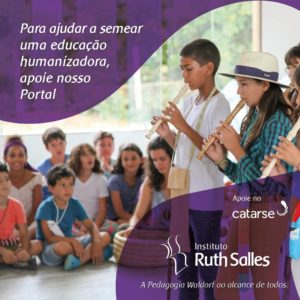Education and the art of make-believe
by Rubens Salles
In Waldorf schools, theater is a very important pedagogical activity, being performed by all elementary school classes and also by the 11th year of high school. In it, what is important is not the final representation for the parents or the school community, but the educational process that involves all its preparation.
Each play is made for students to experience a theme, story or characters that their teacher deems important for a given moment in their education.
The make-believe is an essential element for the development of our personality, because, playing characters, heroes, villains, sages, adventurers, idealists, petty, nobles, commoners, gods, etc., children and adolescents experience courage and fear, solidarity and greed, joy and sadness, humor and bitterness, loyalty and betrayal, love and hate, etc., and this playful experience teaches you to appreciate what is good and dislike what is bad, thus helping to strengthen your character. Putting himself in the place of another, experiencing a way of thinking and feeling life that is different from his own, the young person develops tolerance and understanding.
Through theater, the art of speech, diction, and different types of language are also worked on, according to the context and characteristics of each play. The language used is always a little above what is conventional for a given age, but children like to say new words, or phrases of poetic beauty, which contribute to enriching their knowledge. Whenever possible, there are also sung parts.
In theater, as the text is included in a dramatic context, its meanings are apprehended by the small actors in much more depth than, for example, their reading in a book allows. In the same way, says the author, musicality is also privileged.
“The constant presence of a meaning, hovering and running through the entire staging of the dramatic text, gives the musical track meanings. Theater brings to music its load of narrative meaning, contextualizing it and, in this way, giving it accentuated contents. This process, which encourages children and adolescents to seek different forms of interpretation, favors them in their musicality. In this way, the theater gives an injection of content into the musical aesthetic sense, favoring it on the expressive plane.”(1) Pedro Paulo Salles
Socialization is also encouraged in the theater, as it is a collective action, in which everyone gets involved with a common goal. Unlike other artistic or sports activities, in which some characteristics, or personal qualities, can make it difficult for some children to participate - the chubby ones, for example, may not do well to dance, or to jump, the out of tune to sing - the Theater allows all children to participate, and benefit from the lived experience.
Special attention is given to the poetic, linguistic and musical quality of the pieces, so that they help to develop in children a more refined aesthetic sense, which allows them to differentiate, appreciate and value the beautiful. There is already a large collection of plays with these characteristics, which were written for more than 50 years, mainly by the poet and playwright Ruth Salles, for use in Waldorf elementary schools. Part of this collection is published in the Teatro na Escola Collection, which is part of the material accessible to schools, but each experienced teacher can also create plays for their students.
The pieces represented are chosen by the class teacher according to the age of their children, their educational needs, or the curricular content being worked on at the moment. Thus, there are pieces about fairy tales, legends, themes of nature, folklore, mythology, medieval epics, Brazilian and universal historical facts, mathematics, Portuguese grammar, etc. Theater as a cross-cutting theme enhances the learning of various subjects, as the playful experience makes the student appropriate the content experienced.
Experienced teachers can also make therapeutic use of theater with students who have very one-sided temperaments, casting them in roles that may represent a difficulty they need to overcome.
Waldorf teachers learn the most appropriate ways of working with theater in the classroom, according to the age group of the children. It is an activity that has great importance in the pedagogical context.
“Floating between feeling, acting and thinking are, on the social plane, ethics and morals. Theater is all that, it is feeling and thinking, and it is action with all its moral and ethical burdens. Thus, it can enable the child and adolescent who participate in it, and even the teacher himself, to reflect deeply on being. The theater, with the poetics of its text, with its corporeality, with the syntax of the voices, with the aesthetics of the scenic spectacle, with the semantics of the songs and with its flow of time similar to the time lived, is an intense workshop of life.”( two) Pedro Paulo Salles
See the links below for pedagogical guidelines for the use of pedagogical theater according to the age of the children:
Theater for children aged 6 to 7 years - pedagogical guidelines
Theater for 8 year olds – pedagogical guidelines
Theater for 9-year-olds – pedagogical guidelines
Theater for 10-year-olds – pedagogical guidelines
Theater for 11 year olds – pedagogical guidelines
Theater for 12/13 year olds – pedagogical guidelines
Bibliography
- SALES, Pedro Paulo. Presentation of the Gift of Word Project to the Ministry of Culture. 2003, p.7.
- SALES, Pedro Paulo. Presentation of the Gift of Word Project to the Ministry of Culture. 2003, p.8.
***


